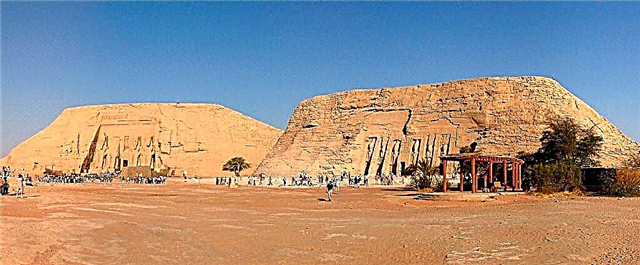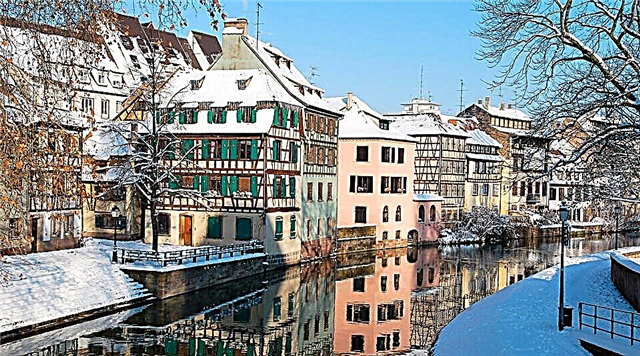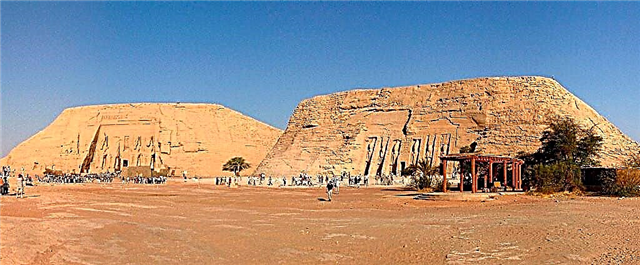To the south of the Egyptian city of Aswan, a few tens of kilometers from the border with Sudan, there is an ancient monument, the uniqueness of which is undeniable. This is a complex of two ancient Egyptian temples of Abu Sibel carved into the rock. Today they are located on the shores of the huge artificial Lake Nasser, formed as a result of the construction of the famous Aswan Dam in the second half of the last century. For Egypt, it was the construction site of the century, which included large-scale, unique in the history of "resettlement" of ancient monuments to a place safe from water. They were dismantled stone by stone and carefully transported to a higher place. The largest of the displaced antiquities was the Abu Simbel complex.
Discovery history
Now no one undertakes to argue for what reasons for many centuries these ancient buildings were covered with sand, and for a long time were hidden from the eyes of mankind. The history of the discovery of these temples is accidental and dates back to the beginning of the 19th century. It was an ordinary walk of the Swiss traveler and orientalist Johann Burckhardt. He was wandering along the sandy hollows of the left bank of the Nile when he suddenly saw fragments of huge statues located 200 meters apart. At that moment it was possible to understand that they are huge, but it was unrealistic to determine the pose of the statues, whether they are standing or sitting. From that moment on, archaeological work was carried out by various expeditions for many years. And only by the end of the 19th century, the whole world learned about the found antiquities of Abu Simbel.

Construction and architecture
The chronicle of the construction of this complex is known today by the works of historians. It refers to the end of the New Kingdom era. The town of Abu Simbel and the temples built in the area have become silent eyewitnesses to the period of decline in the culture of Ancient Egypt. In the 13th century, to commemorate the victory of Kadesh over the Hittites, the Egyptian ruler Ramses II the Great ordered two temples to be cut down in the sandy rock. The first is dedicated to the ruler himself - the Great Temple of Ramses II, and the second - to the goddess Hathor, whose image he associated with his beautiful wife Nefertari.
The entrance to the Great Temple is not built in the tradition of Egyptian sanctuary structures. There is no naos - a special room intended for a sculptural statue of the Deity. And the sculptures of the Gods meet visitors immediately, from the outside of the sanctuary. The twenty-meter statues depict Ramses II himself, seated on a throne with his back to the temple, surrounded by the Gods: Ra-Horus, Amon-Ra and Ptah. Dressed in ceremonial robes with a double crown on their heads, they symbolize power over the entire powerful state of Upper and Lower Egypt. At the foot of the giants, the images of the ruler's family members contrast in size: the mother, wife and children of the pharaoh.

From a bright, sunlit day, visitors enter the twilight of the inner halls, which creates a feeling of meekness and obedience. The inner plan of the sanctuary consists of four rooms, sequentially located one after another. The first hall was accessible for visiting by ordinary Egyptians, the second - for the nobility, the third - for the priests, and only the pharaoh himself with his retinue could enter the last. The halls are filled with sculptural statues of the pharaoh in the image of Osiris, and the walls are painted with battle scenes from the campaigns of Ramses the Great. Everything is subordinated to one goal - the deification and exaltation of the Pharaoh himself.

The giant statues of the main facade of the temple were always visible from afar. The first rays of sunlight painted the figures of the colossus in a bright brown color, and against the background of their own black giant shadows, they looked eerily majestic.
Legends
The history of the main temple of the Abu Simbel complex is shrouded in legends and interesting for its optical surprises. The guides always tell visitors the story of the "weeping statues". It is said that to this day, the giants at the entrance to the temple at dawn emit sounds resembling a groan. The people considered this to be a cry for their sons. Scientists have found a completely scientific explanation for this phenomenon. As the sun rises, the temperature difference between the air and the sandstone increases sharply, and the movement of the rock in the cracks occurs with strange sounds, similar to grinding. But legends allow the sculptures to give a human appearance, and to realize that even the Deities can cry, much more understandable to the common man.
The most amazing thing that especially attracts pilgrims to Abu Simbel is the optical effect that occurs in the Great Temple during the movement of the sun. The engineering structure of the sanctuary is thought out in such a way that only twice a year, in February and October, the sun's rays penetrate into the interior of the temple. Moving along the suite of halls, sunlight penetrates into the farthest room, where it floods the face of the statue of Ramses with radiance, leaving in the darkness the statue of Ptah, the ruler of the underworld. It is on these days that the influx of visitors to the temple increases significantly.

The Small Temple is located literally 100 meters from the Temple of Ramses. Its construction was dedicated to the goddess Hathor - the mythological deity of heaven, femininity and fun, personifying the image of the wife of Pharaoh Nefertari. Modesty and smaller scale, in comparison with the main building, in no way detract from the interest in it. Here the facade is represented by six huge full-length statues, and their location in huge niches and the play of light and shadow give them great monumentality. Passing the entrance, visitors enter a dark columned hall leading to the sanctuary. The holy of holies contains a statue of a sacred cow - the image of the goddess Hathor. In front of the statue is an image of Ramses the Great. This arrangement of images symbolized the protection and patronage of the goddess for the ruler.
Speaking about today's historical complex Abu Simbel, one cannot but say that it is also a monument to the unimaginable efforts made to save it by volunteers from many countries. Millions of travelers today have the opportunity to touch another artifact of the ancient civilization of Egypt. And given the remoteness of the location of the temples from Cairo (more than 1200 km), to understand and appreciate the power and size of the ancient empire.
How to get there
Previously, the Nubian region of Egypt could only be reached by plane (to the nearest city of Aswan). But today sightseeing buses regularly come here, replacing groups of tourists one after another. For travelers planning their trip on their own, it would be wiser to come to Aswan for a day or two. From Aswan, the trip to Abu Simbel will be less tiring. You will need to overcome about 250 km. And in this case, there will be an opportunity to see with your own eyes the famous Aswan Dam with a beautiful reservoir, to visit Philae Island, Kitchener's Garden Island, Kalabsha Temple, built in the 1st century BC. and the mausoleum of the Aga Khan.
If you still could not decide what to choose: Egypt or Turkey, we recommend reading our article.











